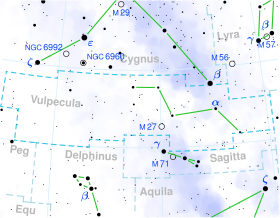30 Vulpeculae
| Observation data Epoch J2000 Equinox J2000 | |
|---|---|
| Constellation | Vulpecula |
| Right ascension | 20h 44m 52.50423s[1] |
| Declination | 25° 16′ 14.2538″[1] |
| Apparent magnitude (V) | 4.91[2] |
| Characteristics | |
| Spectral type | K1 III[3] |
| U−B color index | +1.18[2] |
| B−V color index | +1.19[2] |
| Astrometry | |
| Radial velocity (Rv) | +30.00[4] km/s |
| Proper motion (μ) | RA: −30.988[1] mas/yr Dec.: −184.648[1] mas/yr |
| Parallax (π) | 9.3255 ± 0.1537 mas[1] |
| Distance | 350 ± 6 ly (107 ± 2 pc) |
| Absolute magnitude (MV) | −0.07[5] |
| Orbit[6] | |
| Period (P) | 2,506±4 d |
| Eccentricity (e) | 0.383±0.023 |
| Periastron epoch (T) | 42511±29 MJD |
| Argument of periastron (ω) (secondary) | 272±5° |
| Semi-amplitude (K1) (primary) | 4.69±0.13 km/s |
| Details | |
| Mass | 1.55[7] M☉ |
| Radius | 21.68+0.47 −0.63[1] R☉ |
| Luminosity | 173.3±3.3[1] L☉ |
| Surface gravity (log g) | 2.47[8] cgs |
| Temperature | 4,498+67 −48[1] K |
| Metallicity [Fe/H] | −0.10[5] dex |
| Rotational velocity (v sin i) | 1.5[9] km/s |
| Age | 4.20[7] Gyr |
| Other designations | |
| Database references | |
| SIMBAD | data |
30 Vulpeculae is a binary star system in the northern constellation of Vulpecula, located mid-way between Epsilon Cygni and a diamond-shaped asterism in Delphinus. It is visible to the naked eye as a faint, orange-hued point of light with an apparent visual magnitude of 4.91.[2] The system is located approximately 350 light years away from the Sun based on parallax,[1] and is drifting further away with a mean radial velocity of +30 km/s.[4] The system has a relatively high proper motion, traversing the celestial sphere at the rate of 0.186 arc seconds per annum.[11]
The variable radial velocity of this system was announced in 1922 by W. W. Campbell. It is a single-lined spectroscopic binary system with an orbital period of 6.86 years and an eccentricity of 0.38. The a sin i value is 149 ± 4 Gm (1.00 ± 0.03 AU), where a is the semimajor axis and i is the orbital inclination. This provides a lower bound on the true semimajor axis.[6]
The visible component is an aging giant star with a stellar classification of K1 III[3] and an estimated age of 4.20[7] billion years old. Having exhausted the supply of hydrogen at its core, the star has expanded to 22[1] times the Sun's radius. It has 1.55[7] times the mass of the Sun and is radiating 173[1] times the Sun's luminosity from its swollen photosphere at an effective temperature of 4,498 K.[1]
References
- ^ a b c d e f g h i j k l Brown, A. G. A.; et al. (Gaia collaboration) (August 2018). "Gaia Data Release 2: Summary of the contents and survey properties". Astronomy & Astrophysics. 616. A1. arXiv:1804.09365. Bibcode:2018A&A...616A...1G. doi:10.1051/0004-6361/201833051. Gaia DR2 record for this source at VizieR.
- ^ a b c d Ducati, J. R. (2002). "VizieR Online Data Catalog: Catalogue of Stellar Photometry in Johnson's 11-color system". CDS/ADC Collection of Electronic Catalogues. 2237. Bibcode:2002yCat.2237....0D.
- ^ a b Keenan, P. C.; McNeil, R. C. (1989). "The Perkins catalog of revised MK types for the cooler stars". The Astrophysical Journal Supplement Series. 71: 245. Bibcode:1989ApJS...71..245K. doi:10.1086/191373.
- ^ a b Famaey, B.; et al. (2005). "Local kinematics of K and M giants from CORAVEL/Hipparcos/Tycho-2 data". Astronomy & Astrophysics. 430: 165–186. arXiv:astro-ph/0409579. Bibcode:2005A&A...430..165F. doi:10.1051/0004-6361:20041272. S2CID 17804304.
- ^ a b Anderson, E.; Francis, Ch. (2012). "XHIP: An extended hipparcos compilation". Astronomy Letters. 38 (5): 331. arXiv:1108.4971. Bibcode:2012AstL...38..331A. doi:10.1134/S1063773712050015. S2CID 119257644. Vizier catalog entry
- ^ a b Griffin, R. F. (August 1983). "Spectroscopic binary orbits from photoelectric radial velocities. Paper 51: 30 Vulpeculae". The Observatory. 103: 199–203. Bibcode:1983Obs...103..199G.
- ^ a b c d Luck, R. Earle (2015). "Abundances in the Local Region. I. G and K Giants". Astronomical Journal. 150 (3). 88. arXiv:1507.01466. Bibcode:2015AJ....150...88L. doi:10.1088/0004-6256/150/3/88. S2CID 118505114.
- ^ McWilliam, Andrew (December 1990). "High-resolution spectroscopic survey of 671 GK giants. I - Stellar atmosphere parameters and abundances". Astrophysical Journal Supplement Series. 74: 1075–1128. Bibcode:1990ApJS...74.1075M. doi:10.1086/191527.
- ^ De Medeiros, J. R.; et al. (October 2002). "The Rotation of Binary Systems with Evolved Components". The Astrophysical Journal. 578 (2): 943–950. arXiv:astro-ph/0207288. Bibcode:2002ApJ...578..943D. doi:10.1086/342613. S2CID 16196039.
- ^ "30 Vul". SIMBAD. Centre de données astronomiques de Strasbourg. Retrieved 2019-06-27.
- ^ Lépine, Sébastien; Shara, Michael M. (March 2005). "A Catalog of Northern Stars with Annual Proper Motions Larger than 0.15" (LSPM-NORTH Catalog)". The Astronomical Journal. 129 (3): 1483–1522. arXiv:astro-ph/0412070. Bibcode:2005AJ....129.1483L. doi:10.1086/427854. S2CID 2603568.

